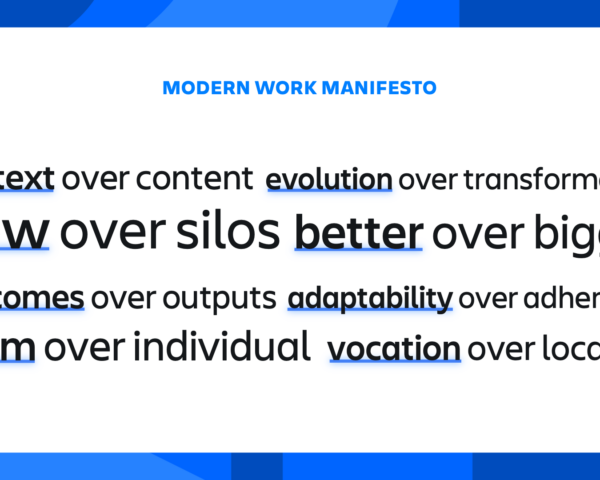If you do knowledge work, you work in a distributed world. Distributed work happens on the internet. It can be collaborating on an online doc or using a project management tool. In some cases, distributed work is also remote work, but sometimes it’s hybrid or fully in-person. The point is, distributed work isn’t really about where you do the work, but rather how you do the work.
So whether you work in an office space or from home, an effective distributed work model requires strategic thought and planning to avoid misalignment and confusion.
This is especially true when it comes to internet-based collaboration tools and processes. In our recent study of Fortune 500 executives leading distributed teams, we found that only 13% of execs felt their teams had clarity on the work needed to be done.
Distributed teamwork is more effective and creative when you set clear goals and processes. At Atlassian, we call this intentional togetherness. That means coming together to hammer out the toughest problems, improve processes, and set a strategy for how to use Atlassian tools to stay aligned.
Thanks to Atlassian’s Team Anywhere Lab, a group of behavioral scientists who build hypotheses and study the hardest things about how to work differently, we’re always capturing opportunities to work better as a distributed workforce.
Annie Dean, Atlassian’s Global Head of Team Anywhere, and Erika Trautman, SVP of Product for Work Management, sat down (virtually) to discuss the strategies and ways our products are used for solving modern work challenges within Atlassian’s highly distributed 10,000+ team.
Let’s dive into six solutions they discussed and the Atlassian tools that can help you succeed in a distributed world.
1. Replace meetings with async collaboration
Make sure team meetings are not a dependency to share information or build company culture. Meetings tend to take up too much of employee work schedules and more often than not doesn’t get you anywhere. Our study on meetings found that 78% of meetings don’t meet their intended objective. And more than half of respondents extend their workday into later hours because they don’t have time to accommodate meetings AND the work they need to get done.
You can do the same work, get the same message across, and collaborate effectively with asynchronous tools and processes. One way to cut down on meetings and gain back those work hours is to use video platforms like Loom. Loom recordings allow the viewer to:
- Control timing and pace: Listen to a Loom recording when it works for your schedule, and put it on 1.2 speed or faster to get to the point quickly.
- Give input: Comment directly on key points in the video and respond to feedback.
- Engage with personality: Add emojis to convey understanding and support
.
2. Make work social with Loom
Loom makes collaboration among teams more natively social. Plus, who doesn’t love seeing a friendly face in the space they work day in and day out? If you can see a bit into their home or office space, they become not just another name on the screen, but a real person you can look forward to collaborating with.
For some things like one on one check-ins, synchronous face-to-face meetings are still important and crucial for relationship building. But for most situations, Loom videos are just as effective, if not more effective, at keeping distributed teams aligned. Use Loom to:
- Broadcast company-wide messages more engagingly than an email or Slack message.
- Clarify objectives across different time zones and geographical locations when synchronous meetings aren’t possible.
- Create a sense of connection by showing people’s faces, conveying their emotional landscapes and sensibilities, especially for remote workers who rarely meet in person.
- Quickly share and explain challenges or ideas, like software bugs, design mockups, or complicated spreadsheets.
Loom can help transform how work is communicated and gets done. Whether your design team walks you through a wireframe or the CEO makes an important announcement, Loom makes asynchronous collaboration more engaging and fun.
Pro tip: Run a Loom challenge. At Atlassian, we’ve challenged our team members to cut out as many meetings as possible to save thousands of hours across the company. It’s been great fun to see what people come up with!
3. Break down silos and increase work visibility
If you want to work more cohesively, you need to get rid of silos and increase work visibility across the organization. Org charts are one way of organizing work by relegating roles and responsibilities to the people in your company. But the org chart itself does not dictate the way work really gets done from project to project.
Instead, people who sign up to drive a goal are individuals who often span across different teams, functions, and reporting lines. It’s imperative to break down those silos, or the work will never get done properly.
Shared goals and project management tools help increase visibility into who is working on what and how it’s going, no matter which department you’re in. When you remove the layers that block access to information, you remove silos.
4. Implement self-serve knowledge sharing with Atlas
No matter who you are at your company, information should be self-serve. A tool like Atlas acts as a central source of knowledge that is self-serve, resulting in an async environment without silos. Atlas lets you organize your entire company’s goals and key results and provide complete visibility on progress. It also makes it so you are less dependent on meetings to get on the same page with your team.
As a manager, you’ll receive short, tweet-length updates on all the goals that matter to you and your team every week. You can click through to learn more and check how a project or goal progresses. In this way, Atlas:
- Increases visibility: You can check your team and other teams’ progress, leave comments, ask questions, or follow up on dependent tasks.
- Decreases feelings of micromanagement: Employees have a better experience when they don’t need to respond to constant requests for a status update.
- Reduces meetings: Status report meetings are unnecessary when all the information is readily available on the platform.
There isn’t one right way to use Atlas or tools like it. But you do need to implement a consistent way of working around your tools, especially if teams work with different tools but want to maintain a unified workflow and streamline information to relevant stakeholders.
Pro tip: Atlas integrates with the rest of the Atlassian tool suite, enabling seamless collaboration and data sharing across our other platforms like Jira and Confluence.
5. Experiment with different collaboration styles
Every company today is being asked to undergo change. That means there’s no better time than now to experiment with different collaboration styles and working methods. This could be a dedicated group in your organization or a goal for select teams and individuals to actively work on.
But when it comes to adopting new ways of working, you need 10-50% of a team to be willing to experiment and adopt new norms to successfully drive the change. If you don’t see that level of adoption, you’ll see outdated norms cement instead.
Here are a few tips for encouraging leaders to experiment with their teams:
- Lead with empathy. Team members should know you expect change to be challenging, not instant or easy.
- Remind everyone that some changes might not be right for your organization, but it’s still better to try and discover that before pivoting to something new again.
- Start small. Don’t try to make big, sweeping changes, but smaller and more attainable ones.
- Make it about employee engagement. You could turn it into a competition or a game, and give all team members a voice in the various trials.
Pro tip: Atlassian is interested in how to hack opportunities to work differently and find new ways to use our tools. We’re always publishing what we learn, so stay tuned here.
6. Use Confluence for page-led collaboration
One way to incentivize your teams to keep trying new things is to start with relatively low-lift changes with immediate positive impact. For example, at Atlassian, we use page-led collaboration, creating pages in Confluence that facilitate synchronous meetings. Here’s how it works for these real-time meetings:
- Before a planned meeting, put together a document outlining everything that will be discussed.
- Begin the meeting by sharing the page with all meeting attendees.
- Start the meeting and use the first 5 minutes for a silent pre-read to allow everyone to get on the same page.
- Use the rest of that meeting to get aligned on the topic and unblock glaring issues through substantive question-asking and discussion.
After implementing this new working style at Atlassian, we found that attendees believed this was a better way of working. People who used this format were stronger writers, better communicators, and wrote more succinct pages.
Getting intentional about your tools
After the pandemic, newly remote teams grabbed for any and all tools that could help them get the job done. But they didn’t really consider what was truly useful for their organization. A clear tool strategy forces you to be deliberate and thoughtful about how tools will help you drive work.
You need different tools for different ways of working. Atlassian thinks about work as an entire product tooling lifecycle. You can conceptualize and ideate work with Confluence and Loom. Then, transfer that work to structured projects in Jira. And finally, communicate goals and status updates in Atlas.
Remember, great work happens wherever you’re working from. And distributed work is only made better when you unlock a system of tools that transforms your company from a culture of administration to a culture of makers.
Want to learn more?
Check out Annie and Erika’s episode in Atlassian’s Lightning Talks:



